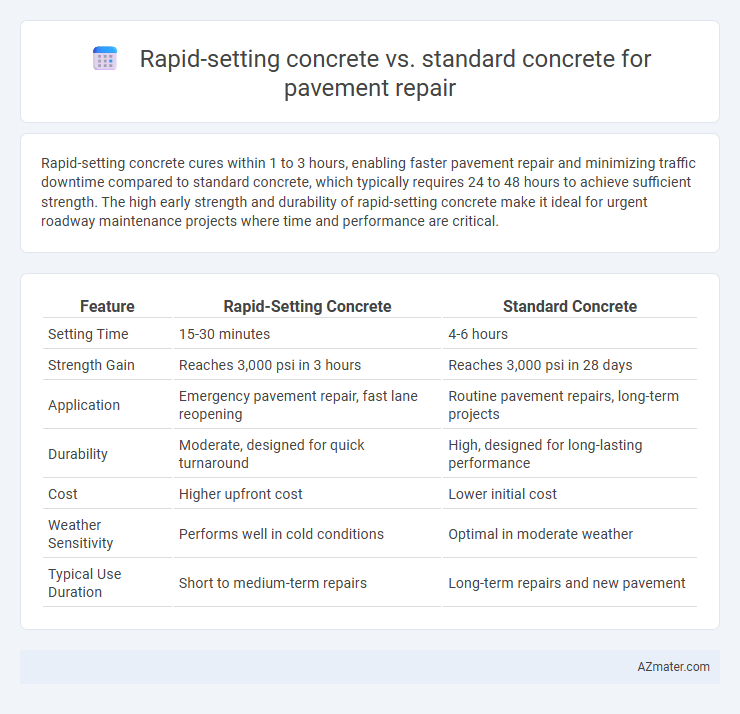Rapid-setting concrete cures within 1 to 3 hours, enabling faster pavement repair and minimizing traffic downtime compared to standard concrete, which typically requires 24 to 48 hours to achieve sufficient strength. The high early strength and durability of rapid-setting concrete make it ideal for urgent roadway maintenance projects where time and performance are critical.
Table of Comparison
| Feature | Rapid-Setting Concrete | Standard Concrete |
|---|---|---|
| Setting Time | 15-30 minutes | 4-6 hours |
| Strength Gain | Reaches 3,000 psi in 3 hours | Reaches 3,000 psi in 28 days |
| Application | Emergency pavement repair, fast lane reopening | Routine pavement repairs, long-term projects |
| Durability | Moderate, designed for quick turnaround | High, designed for long-lasting performance |
| Cost | Higher upfront cost | Lower initial cost |
| Weather Sensitivity | Performs well in cold conditions | Optimal in moderate weather |
| Typical Use Duration | Short to medium-term repairs | Long-term repairs and new pavement |
Introduction to Pavement Repair Methods
Rapid-setting concrete offers significantly faster curing times compared to standard concrete, making it ideal for urgent pavement repairs that require minimal downtime. While standard concrete typically requires 24 to 48 hours to achieve sufficient strength, rapid-setting concrete can reach functional strength in just 1 to 4 hours, enabling quicker restoration of traffic flow. The choice between rapid-setting and standard concrete depends on project urgency, load-bearing requirements, and environmental conditions impacting pavement durability.
What is Rapid-setting Concrete?
Rapid-setting concrete is a high-performance blend formulated to achieve strength within hours rather than days, using specialized cement and additives like calcium sulfoaluminate. It is designed for pavement repair that requires quick reopening to traffic, minimizing downtime and maintenance disruption. Rapid-setting concrete typically reaches compressive strength of 3,000 psi in just 2 to 4 hours, compared to standard concrete which can take 28 days to reach similar strength.
Understanding Standard Concrete
Standard concrete for pavement repair typically consists of a mixture of cement, aggregates, water, and admixtures, designed to achieve a balance between strength and workability. Its curing time ranges from several hours to days, allowing for gradual strength gain and durability in various environmental conditions. This slower setting process provides sufficient time for proper finishing and jointing but may result in longer downtime for road users compared to rapid-setting alternatives.
Key Differences Between Rapid-setting and Standard Concrete
Rapid-setting concrete achieves high early strength within hours, enabling faster pavement repairs and reduced downtime, whereas standard concrete requires curing periods of 24 to 48 hours or more before load-bearing use. The mix design of rapid-setting concrete includes specialized cementitious materials and chemical accelerators that promote quick hydration and strength gain, unlike conventional Portland cement in standard concrete. Rapid-setting concrete exhibits enhanced resistance to freeze-thaw cycles and deicing salts, making it ideal for urgent repairs in cold climates, while standard concrete offers long-term durability under normal curing conditions.
Strength and Durability Comparisons
Rapid-setting concrete achieves compressive strengths of up to 3,000 psi within 3 hours, enabling faster pavement reopening compared to standard concrete, which typically reaches similar strengths in 24 to 48 hours. The accelerated curing process of rapid-setting concrete enhances the early load-bearing capacity while maintaining long-term durability often comparable to standard mixes. However, standard concrete typically exhibits superior resistance to freeze-thaw cycles and chemical attacks over extended periods, making it preferable for environments with aggressive exposure conditions.
Setting Time and Traffic Reopening
Rapid-setting concrete achieves initial set within 30 to 60 minutes, allowing traffic reopening typically within 2 to 4 hours, which significantly reduces downtime on pavements. In contrast, standard concrete requires 24 to 72 hours to reach sufficient strength for traffic load, extending repair timelines and causing prolonged traffic disruption. The accelerated setting time of rapid-setting concrete is ideal for urgent pavement repairs where minimizing road closure is critical.
Cost Implications and Budget Considerations
Rapid-setting concrete typically incurs higher upfront costs compared to standard concrete due to specialized materials and accelerated curing processes, but it reduces labor and traffic disruption expenses by enabling faster reopening of pavements. Standard concrete offers lower initial material and placement costs, yet longer curing times can extend project duration, increasing indirect costs such as traffic management and user delays. Budget considerations should balance the premium price of rapid-setting concrete against potential savings in downtime and maintenance, especially for high-traffic or time-sensitive pavement repairs.
Environmental Impact and Sustainability
Rapid-setting concrete for pavement repair reduces environmental impact by minimizing curing time, thereby decreasing traffic disruptions and associated emissions from idling vehicles. Standard concrete requires longer curing periods, leading to extended road closures and higher fuel consumption from detoured traffic. The use of rapid-setting concrete enhances sustainability through lower carbon footprint due to reduced construction duration and energy consumption.
Best Scenarios for Using Rapid-setting vs Standard Concrete
Rapid-setting concrete is ideal for emergency pavement repairs where quick reopening to traffic is critical, such as airport runways, highways, and urban roads requiring minimal downtime. Standard concrete suits long-term projects with less urgency, providing superior durability and strength for pavements subjected to heavy loads and extended curing times. Choosing rapid-setting concrete accelerates repair cycles, while standard concrete ensures greater longevity under routine maintenance conditions.
Conclusion: Choosing the Right Concrete for Pavement Repair
Rapid-setting concrete offers faster curing times and early strength gain, making it ideal for urgent pavement repairs requiring minimal downtime. Standard concrete provides long-term durability and cost-effectiveness, suitable for less time-sensitive projects with heavier load demands. Selecting the appropriate concrete depends on balancing repair urgency, traffic conditions, and budget constraints to ensure optimal pavement performance.

Infographic: Rapid-setting concrete vs Standard concrete for Pavement repair
 azmater.com
azmater.com